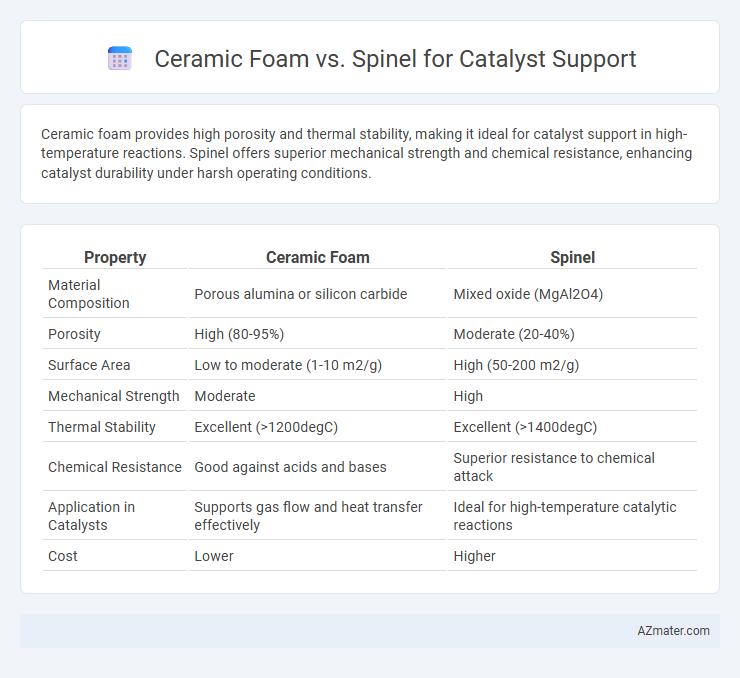Ceramic foam provides high porosity and thermal stability, making it ideal for catalyst support in high-temperature reactions. Spinel offers superior mechanical strength and chemical resistance, enhancing catalyst durability under harsh operating conditions.
Table of Comparison
| Property | Ceramic Foam | Spinel |
|---|---|---|
| Material Composition | Porous alumina or silicon carbide | Mixed oxide (MgAl2O4) |
| Porosity | High (80-95%) | Moderate (20-40%) |
| Surface Area | Low to moderate (1-10 m2/g) | High (50-200 m2/g) |
| Mechanical Strength | Moderate | High |
| Thermal Stability | Excellent (>1200degC) | Excellent (>1400degC) |
| Chemical Resistance | Good against acids and bases | Superior resistance to chemical attack |
| Application in Catalysts | Supports gas flow and heat transfer effectively | Ideal for high-temperature catalytic reactions |
| Cost | Lower | Higher |
Introduction to Catalyst Support Materials
Ceramic foam and spinel are widely used catalyst support materials due to their high thermal stability and mechanical strength, which enhance catalytic performance and durability. Ceramic foam offers a porous, lightweight structure with excellent mass transfer properties, making it ideal for reactions requiring efficient fluid flow and heat distribution. Spinel, a crystalline oxide with a stable mixed-metal composition, provides superior resistance to sintering and chemical degradation under harsh catalytic conditions.
Overview of Ceramic Foam as Catalyst Support
Ceramic foam, widely utilized as a catalyst support, offers a highly porous structure that enhances mass transfer and provides a large surface area for active catalyst dispersion. Its interconnected pore network facilitates efficient fluid flow, reducing pressure drop compared to traditional packed beds, which improves reaction efficiency in various catalytic processes. Additionally, ceramic foam exhibits excellent thermal stability and mechanical strength, making it suitable for high-temperature applications such as automotive exhaust treatment and chemical reactors.
Understanding Spinel Structures in Catalysis
Spinel structures, characterized by the general formula AB2O4, provide exceptional thermal stability and oxygen ion conductivity, making them highly effective as catalyst supports compared to traditional ceramic foams. The unique arrangement of metal cations in tetrahedral and octahedral sites enhances active metal dispersion and resistance to sintering under harsh reaction conditions. These properties enable spinels to improve catalytic performance in processes such as oxidation and reforming by facilitating better reactant adsorption and maintaining structural integrity over extended use.
Surface Area and Porosity Comparison
Ceramic foam exhibits higher porosity, typically above 80%, offering an interconnected open-cell structure that enhances fluid flow and mass transfer, whereas Spinel catalysts possess lower porosity but provide superior mechanical strength and thermal stability. Spinel materials, such as MgAl2O4, tend to have reduced surface area compared to ceramic foams, limiting active site availability but improving catalyst durability under harsh reaction conditions. The greater surface area of ceramic foam supports promotes enhanced catalytic activity but may sacrifice longevity, making the choice dependent on specific process requirements.
Thermal Stability and Resistance Analysis
Ceramic foam and spinel exhibit distinct thermal stability and resistance characteristics critical for catalyst support applications. Ceramic foam offers high porosity and excellent thermal shock resistance, maintaining structural integrity at temperatures above 1200degC, making it suitable for rapid temperature fluctuations. Spinel, a crystalline oxide with a robust lattice structure, provides superior resistance to sintering and chemical degradation at elevated temperatures up to 1500degC, enhancing catalyst longevity in harsh oxidative environments.
Mechanical Strength: Ceramic Foam vs Spinel
Ceramic foam exhibits superior mechanical strength due to its interconnected porous structure, allowing high compressive resistance and durability under thermal stress, making it ideal for catalyst supports in harsh environments. Spinel, while chemically stable and resistant to sintering, generally offers lower mechanical strength compared to ceramic foam, limiting its use where high structural integrity is critical. The enhanced toughness and shock resistance of ceramic foam provide significant advantages over spinel in maintaining catalyst performance under mechanical and thermal loading conditions.
Chemical Compatibility With Catalysts
Ceramic foam exhibits excellent chemical compatibility with various catalysts due to its inert nature and resistance to corrosion in harsh reaction environments. Spinel, characterized by its stable crystal structure and high thermal resistance, offers superior chemical stability and minimizes catalyst poisoning in oxidation and reduction reactions. Both materials provide robust support surfaces, but spinel's enhanced chemical compatibility extends catalyst lifespan and performance under corrosive conditions.
Performance in Industrial Applications
Ceramic foam exhibits superior performance as a catalyst support in industrial applications due to its high porosity and thermal stability, enhancing fluid flow and heat transfer efficiency. Spinel materials offer excellent mechanical strength and resistance to sintering, maintaining structural integrity under harsh reaction conditions. The choice between ceramic foam and spinel depends on specific process requirements such as operating temperature, chemical environment, and desired catalytic activity.
Cost Efficiency and Scalability
Ceramic foam offers a cost-effective catalyst support due to its lower production expenses and easier manufacturing scalability compared to spinel, which requires more complex synthesis and higher raw material costs. The open-cell structure of ceramic foam enhances mass transfer while maintaining mechanical strength, enabling large-scale applications without significant performance loss. Spinel supports provide excellent thermal stability and chemical resistance but often incur higher costs that challenge scalability in industrial catalyst systems.
Recent Advances and Future Prospects
Ceramic foam and spinel materials have demonstrated significant improvements in catalyst support applications, with ceramic foams offering superior porosity and mechanical strength that enhance mass transfer and catalyst durability. Recent advances in spinel catalysts focus on improved thermal stability and oxygen mobility, crucial for high-temperature reactions and redox processes. Future prospects include hybrid supports combining ceramic foam structures with spinel coatings to optimize catalytic efficiency, selectivity, and long-term stability in industrial applications.

Infographic: Ceramic foam vs Spinel for Catalyst support
 azmater.com
azmater.com